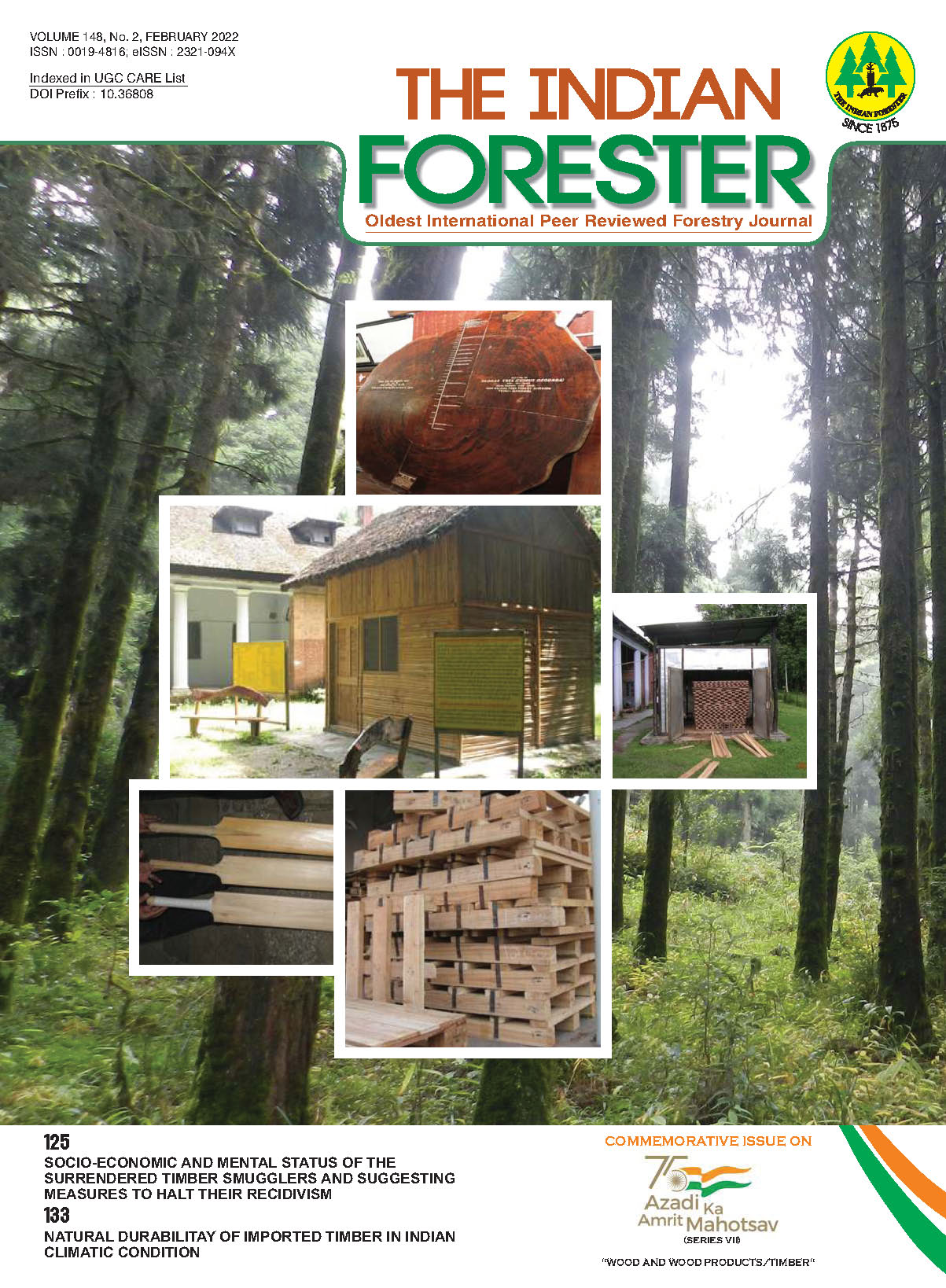Socio-Economic and Mental Status of the Surrendered Timber Smugglers and Suggesting Measures to halt their Recidivism
DOI:
https://doi.org/10.36808/if/2022/v148i2/154285Keywords:
Timber Smugglers, Surrender, Mental Trauma, Livelihood, Self-Employment.Abstract
Present study deals with an assessment of socio-economic and mental status of 372 timber smugglers. These smugglers had surrendered due to valiant effort and holistic approach shown by Sironcha Forest division of Gadchiroli district of Maharashtra, India. However, prevailing socioeconomic issues posed a threat of their recidivism. Present study revealed psycho-socio-economic conditions surrounding the person aftermath the surrender. Smugglers faced many problems prior to the surrender which included mental trauma, home sickness, breakdown of the family relation and threat of life from Naxalites. However, main reason cited for the surrender of timber smugglers was the pressure imposed by the forest department. Thus, there was a need of sustained pressure through patrolling, arresting, punishing etc. Surrender of the smugglers has brought many additional benefits for them such as increase in self-esteem and social respect, decrease in mental stress and alcohol intake, building up of family bonds. Outcomes of the present study suggests that in order to sustain the situation of forest protection, people should be given proper employment opportunity. Self-employment, agricultural activity and animal husbandry were opted by the most people. Creating a small decentralized forestrybased livelihood opportunities would also be a better option if government fails to provide alternative livelihood, there is lurking chance of returning the surrendered smugglers to back to their earlier business. Main hindrance in their development was remoteness and resulting poor infrastructure.References
Berenji B., Chou T. and D'orsogna, M.R. (2014). recidivism and rehabilitation of criminal offenders: a carrot and stick evolutionary game. Plos one, 9(1): 85531. https://doi.org/10.1371/ journal.pone.0085531
Cullen F.T., Jonson C.L. and Nagin D.S. (2011). Prisons do not reduce recidivism: the high cost of ignoring science. The Prison Journal, 93: 48-65.
Cullen F.T. (2002). Rehabilitation and treatment programs. In: Wilson, J.Q., Peterson, J., editors, crime: public policies for crime control, ICS press.
Dhongade S.A. (2016). Inter-block disparity in agricultural development of Gadchiroli district. International journal of current advanced research
FAO, (2005). Best practices for improving law compliance in the forest sector. FAO forestry paper 145, ISBN 9251053812 FAO. (2005). Global Forest Resources Assessment 2005, Progress towards sustainable forest management. Vol. 147 of FAO Forestry Paper. Food and Agriculture Organization of the United Nations, Rome.
Kelkar Committee Report (2013). Report of the high-level committee on balanced regional development issues in Maharashtra government of Maharashtra planning department (2013); Available: https://www.maharashtra.gov.in/site/upload/ WhatsNew/KCR-23122014.pdf.
Khairnar A. and Sen J. (2013). Planning for minimization of socio-economic inequalities within Vidarbha region, Maharashtra, India. R W. World Academy of Science, Engineering and Technology. International Journal of Humanities and Social Sciences, 7(3).
Khanduri S.K. and Mandal R. (2005). National forest policy and wood production- an introspection new Delhi, India: planning commission, government of India.
Likert R. (1932). A technique for the measurement of attitudes. Archives of psychology, 140: 1-55.
Lipsey M.W., Landenberger N.A. and Wilson S.J. (2007). Effects of cognitive-behavioral programs for criminal offenders. Campbell systematic reviews. DOI 10.4073/csr.2007.6
Mackenzie D.L. (2002). reducing the criminal activities of known offenders and delinquents: crime prevention in the courts and corrections. In: sherma l, et al., editors, evidencebased crime prevention, Routledge
Meijaard E., Abram N.K., Wells J.A, Pellier A.S., Ancrenaz M. and Gaveau D.L.A. (2013). People's perceptions about the importance of forests on Borneo. Plos one, 8(9): e73008. Https://doi.org/10.1371/journal.pone.0073008
Nagin D.S., Cullen F.T. and Jonson C.L. (2009). Imprisonment and reoffending. Crime and Justice, 38: 115-200.
Perc M., Donnay K. and Helbing D. (2013). Understanding recurrent crime as system-immanent collective behavior. Plos one, 8, e76063.
Singhal R. M. (1949). Timber Floating in Godavari, Indravati, and Pranhita Rivers. Indian Forester, 75 (8): 300-301.
TERI (the energy and resources institute). 2015. Green growth and forestry in India. New Delhi: the energy and resources institute. 12 pp.
United States Bureau of Justice Statistics (2011). Direct expenditures by criminal justice function, 1982-2007. Vol 5, issue 12, pp 1541-1543, december 2016. Available: http://bjs.ojp.usdoj.gov/content/glance/tables/exptyptab.cfm. Accessed 2013 dec 7.
World bank (2006). Strengthening forest law enforcement and governance: addressing a systemic constraint to sustainable development. The world bank. Report no. 36638-glb. 77 p.
Downloads
Downloads
Published
How to Cite
Issue
Section
License
Unless otherwise stated, copyright or similar rights in all materials presented on the site, including graphical images, are owned by Indian Forester.





